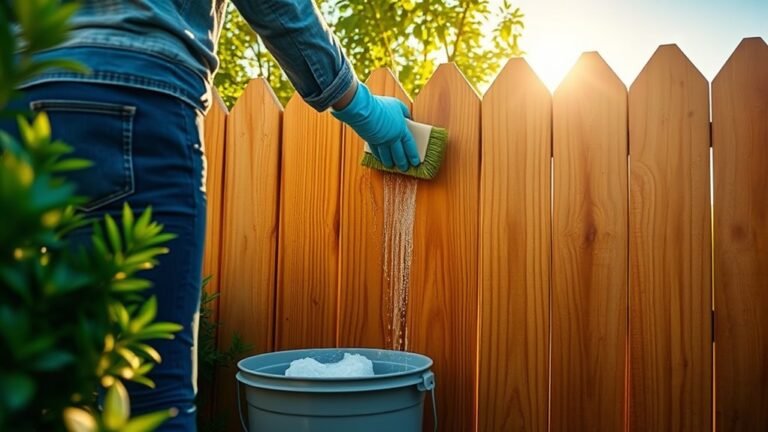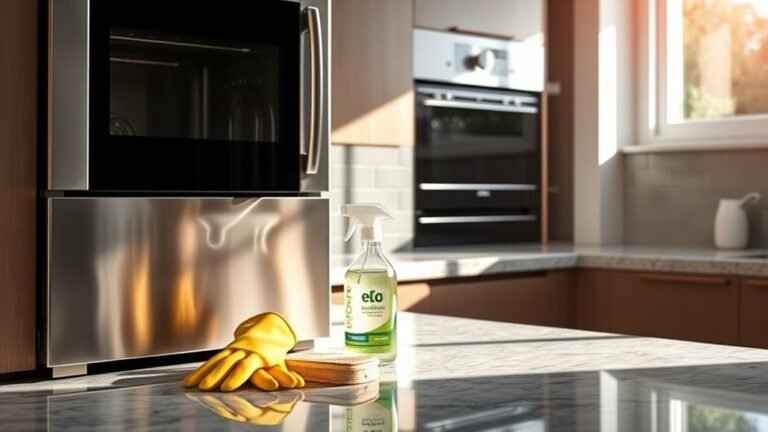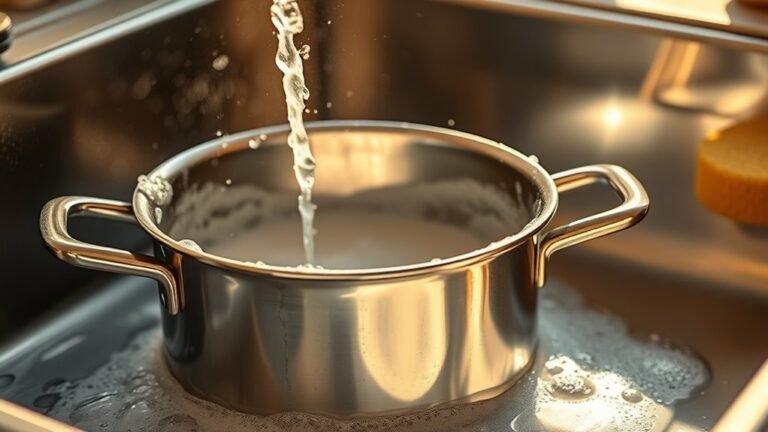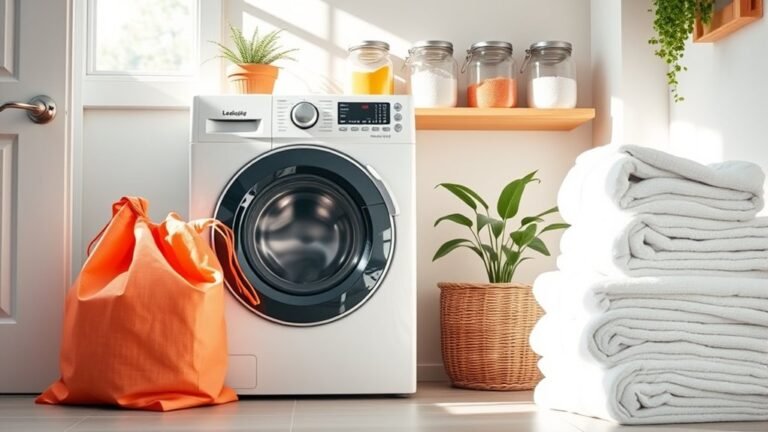Top 10 Tips for Cleaning Conference Table
You’ll want to pick biodegradable, non-toxic cleaners that suit your table’s material and avoid harsh chemicals. Dust weekly with microfiber cloths to prevent buildup, and wipe spills immediately using soft cloths to avoid stains or damage. Protect surfaces using coasters or mats, and polish occasionally for extra shine. Keep humidity between 40-60% to prevent warping, and schedule regular deep cleanings to maintain its form and finish. Following these tips helps guarantee lasting beauty and function—there’s more to explore for a flawless table care routine.
Choose the Right Cleaning Products

When choosing cleaning products for your conference tables, it’s important to pick ones that effectively remove dirt and germs without damaging the surface. You want products that offer strong product effectiveness while respecting your commitment to eco-friendly options. Many conventional cleaners contain harsh chemicals that can erode finishes or leave residues. Instead, seek out biodegradable, non-toxic solutions designed specifically for wood, laminate, or glass surfaces. These options maintain cleanliness without compromising your table’s integrity or your environmental values. By choosing wisely, you guarantee your conference space stays pristine and inviting, all while supporting sustainability. Remember, the right product balances power and gentleness, giving you freedom from worry about harm or waste. This approach keeps your workspace clean and aligns with your eco-conscious lifestyle.
Dust Regularly to Prevent Buildup
You should dust your conference table at least once a week to keep buildup at bay. Using microfiber cloths or electrostatic dusters will trap dust effectively without scratching the surface. Also, consider placing air purifiers nearby and minimizing open windows to reduce dust accumulation.
Frequency of Dusting
Regularly dusting your conference tables is essential to prevent buildup that can dull surfaces and harbor allergens. To keep your space fresh and inviting, you need a consistent cleaning schedule tailored to your environment. For high-traffic rooms, dust accumulation happens faster, so aim for daily or every-other-day dusting. Less-used areas might only require weekly attention. By setting a routine, you avoid overwhelming tasks and maintain the table’s appearance effortlessly. Staying on top of dust means you’ll extend the life of your furniture and create a healthier workspace. Remember, frequency matters as much as technique, so adjust your schedule based on usage and visible dust levels. This approach gives you the freedom to enjoy a clean, polished conference table without hassle.
Best Dusting Tools
Three dusting tools stand out as essentials for keeping your conference table spotless: microfiber cloths, electrostatic dusters, and vacuum attachments. Microfiber cloths excel at trapping dust without scratching surfaces, making them ideal for regular cleaning. Feather dusters offer a lightweight option, perfect for quick dust removal from edges and crevices, but they can sometimes just redistribute dust if not used carefully. Electrostatic dusters attract dust particles efficiently, reaching tight spots without spreading debris. Vacuum attachments with soft brushes are great for removing settled dust without damaging the table’s finish. By incorporating these tools into your routine, you’ll maintain a clean, inviting conference table without hassle. Choose what suits your style and space, and dust regularly to prevent buildup and preserve your workspace’s freedom and freshness.
Dust Prevention Methods
Keeping your conference table free from dust starts with consistent cleaning habits. Dust regularly to prevent buildup and maintain a polished look. Combine effective dust control strategies like using microfiber cloths with environmental solutions such as air filtration systems to reduce airborne particles. These methods help you enjoy a cleaner space without constant effort.
| Dust Prevention Method | Key Benefit |
|---|---|
| Regular Dusting | Stops dust buildup early |
| Air Filtration Systems | Captures airborne dust particles |
| Controlled Humidity Levels | Reduces dust attraction |
Use a Soft Cloth to Avoid Scratches
One essential step in maintaining your conference table’s surface is using a soft cloth when cleaning. Choosing the right soft cloth type, such as microfiber or cotton, plays a vital role in scratch prevention. These materials gently lift dust and dirt without abrasive friction that could damage the finish. Avoid rough fabrics or paper towels, as they may leave micro-scratches or lint behind. When wiping, use light pressure and smooth, circular motions to protect the surface further. This simple habit preserves your table’s sleek appearance and prolongs its life, giving you the freedom to enjoy a pristine workspace without constant worry. By prioritizing soft cloth types for cleaning, you guarantee that your conference table remains scratch-free and ready for every important meeting.
Clean Spills Immediately

Spills can happen at any moment, and cleaning them immediately is essential to prevent stains and damage to your conference table. Effective spill management relies on your immediate response, which keeps your table looking pristine and extends its lifespan. Don’t let a small spill turn into a permanent problem.
Address spills promptly to protect your conference table from stains and damage, preserving its pristine condition.
When a spill occurs, act fast:
- Grab a soft, absorbent cloth to blot—not rub—the spill.
- Use gentle pressure to soak up liquids, avoiding spreading the mess.
- Check for residue and clean again if necessary to guarantee no sticky spots remain.
Avoid Harsh Chemicals on Wood Surfaces
After quickly addressing spills, you’ll want to be careful about the cleaning products you use on wood surfaces. Harsh chemicals can strip the wood’s natural oils, leading to damage and dullness over time. Instead, opt for natural alternatives like diluted vinegar or gentle castile soap solutions. These keep your conference table looking fresh without compromising wood preservation. Avoid ammonia, bleach, or abrasive cleaners—they might clean fast but harm your table’s finish. Using mild, eco-friendly options not only protects the wood but also gives you the freedom to maintain a healthy workspace. Remember, preserving the wood’s integrity means your conference table will stay beautiful and functional for years, saving you from costly repairs or replacements down the line.
Disinfect With Safe Solutions

While keeping your conference table clean is essential, disinfecting it safely guarantees germs don’t spread without damaging the surface. Choose disinfecting agents that are effective yet gentle, avoiding harsh chemicals that can wear down finishes. Safe alternatives like diluted vinegar solutions or alcohol-based sprays with at least 70% isopropyl alcohol work well without compromising your table’s integrity. Remember, using the right disinfectants helps maintain a healthy environment and preserves your freedom from constant repairs.
- Feel confident knowing your workspace is germ-free without sacrificing surface quality.
- Enjoy peace of mind with safe alternatives protecting both health and furniture.
- Take control by selecting disinfecting agents that match your commitment to cleanliness and care.
Disinfect smartly to keep your conference table both pristine and safe for everyone.
Polish the Table for Extra Shine
Bring out the natural beauty of your conference table by polishing it regularly. Using effective polishing techniques not only enhances the table’s appearance but also extends its lifespan. Start by choosing a polish suitable for your table’s material—wood, glass, or laminate—always testing a small area first. Apply the polish with a soft, lint-free cloth, working in gentle, circular motions to evenly distribute shine enhancers. Avoid over-polishing, which can build up residue and dull the surface. Regular polishing removes minor scratches and restores vibrancy, giving your table a professional, welcoming look. By mastering these polishing techniques, you maintain freedom from dullness and wear, ensuring your conference table remains a centerpiece that impresses every time.
Protect the Surface With Mats or Coasters
Mats and coasters are essential tools to protect your conference table from stains, heat marks, and scratches. Using quality table mats and choosing the right coaster materials gives your table a shield against daily wear while maintaining its sleek appearance. Opt for silicone, cork, or leather coasters for durability and style. Table mats not only catch spills but also prevent direct contact with hot mugs or plates, preserving the surface.
- Feel confident hosting meetings without worrying about damage.
- Enjoy peace of mind knowing your table stays pristine.
- Express your style while safeguarding your workspace.
Maintain Humidity Levels to Prevent Warping
You should keep the humidity level around 40-60% to protect your conference table from warping. Low humidity can cause the wood to dry out and crack, damaging the surface. Using a humidifier helps maintain consistent moisture, preserving the table’s shape and finish.
Ideal Humidity Range
Maintaining a humidity level between 40% and 60% is essential to prevent your conference table from warping. Proper humidity control guarantees a stable moisture balance, protecting the wood’s integrity and appearance. When moisture levels fluctuate too much, your table can crack, swell, or warp, compromising its function and your freedom to use it worry-free.
To keep your conference table in top shape, remember to:
- Monitor indoor humidity with a reliable hygrometer
- Use a humidifier or dehumidifier to maintain balance
- Avoid placing the table near direct heat or air vents
Effects of Low Humidity
Although low humidity might seem harmless, it can cause significant damage to your conference table over time. Low humidity effects include drying out the wood, which leads to shrinking, cracking, and warping. These changes compromise both the table’s appearance and structural integrity. To prevent this, humidity control is crucial. By maintaining consistent moisture levels in the room, you reduce the risk of damage and extend your table’s lifespan. Keep in mind that sudden fluctuations in humidity are just as harmful as prolonged dryness. Monitoring humidity and adjusting your environment accordingly guarantees your conference table remains flat, sturdy, and visually appealing. Taking control of humidity isn’t just about preservation—it’s about protecting your investment and keeping your workspace comfortable and functional.
Benefits of Humidifiers
When humidity levels drop, a humidifier can be your best tool to keep conference tables in prime condition. Maintaining optimal humidity prevents wood from drying out and warping, ensuring your furniture stays strong and visually appealing. The humidifier benefits extend beyond protection — it creates a comfortable environment that supports productivity and well-being.
By using a humidifier, you can:
- Preserve the integrity of your conference table, avoiding costly repairs or replacements.
- Enjoy a balanced atmosphere that enhances focus and comfort during meetings.
- Extend the lifespan of your investment by preventing cracks and splitting caused by dry air.
Embracing this simple step lets you protect your space and enjoy the freedom of worry-free maintenance.
Schedule Deep Cleanings Periodically
Since daily wipe-downs only address surface dirt, scheduling deep cleanings periodically guarantees your conference tables stay in top condition. A well-planned cleaning schedule helps prevent buildup of grime, stains, and bacteria that everyday cleaning misses. You’re not just maintaining appearance—you’re extending the table’s lifespan and ensuring a healthy workspace.
| Frequency | Task |
|---|---|
| Weekly | Surface wipe-downs |
| Monthly | Clean under and edges |
| Quarterly | Use specialized cleaners |
| Biannually | Full deep cleaning |
Stick to this schedule to enjoy freedom from last-minute scrambles and keep your conference room inviting. Deep cleaning might seem extra, but it’s the key to hassle-free maintenance and pristine tables that last.
Frequently Asked Questions
How Often Should Conference Tables Be Replaced?
You should consider replacing conference tables based on their lifetime expectancy and material durability. If the table’s material is highly durable, like solid wood or metal, it could last 10-20 years or more. Less durable materials might need replacement every 5-7 years. Pay attention to wear, damage, and how well it meets your needs. Replacing too soon limits freedom, but waiting too long might affect functionality and appearance.
Can Conference Tables Be Cleaned With Natural Homemade Solutions?
You might think natural cleaners and homemade solutions aren’t strong enough for conference tables, but they actually work well and are safer. You can easily mix vinegar, water, and a bit of olive oil to clean and polish wood surfaces without harsh chemicals. These natural cleaners save you money and reduce toxins, giving you freedom from synthetic products while keeping your table spotless and well-maintained. It’s simple, effective, and eco-friendly.
What Is the Best Way to Remove Ink Stains From a Conference Table?
To tackle ink removal effectively, you’ll want to act fast. Dab the stain gently with a cloth soaked in rubbing alcohol or a commercial ink remover—never rub, as that spreads the ink. Afterward, wipe the area with a damp cloth and dry it thoroughly. For stain prevention, consider applying a protective finish or using table covers during meetings. This way, you keep your conference table looking sharp and free from permanent marks.
Are There Specific Cleaning Routines for Glass Conference Tables?
Yes, there are specific routines for glass care to keep your conference table spotless. You should use gentle cleaning products like glass cleaners or a mix of water and vinegar to avoid streaks. Always use a microfiber cloth to prevent scratches. Regularly dust the surface to maintain clarity, and avoid abrasive materials or harsh chemicals. This routine helps preserve your table’s sleek look and gives you the freedom to focus on your meetings without worrying about smudges.
How to Handle Scratches or Dents on Conference Tables?
You might feel like a superhero facing scratches or dents on your conference table, but scratch repair and dent removal don’t require superpowers. For minor scratches, use a scratch repair kit or furniture polish to blend them in. Small dents? A damp cloth and a hot iron can puff the wood back up. If that fails, wood filler and gentle sanding work wonders. Keep your table looking flawless without breaking a sweat!






